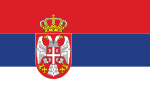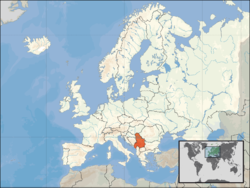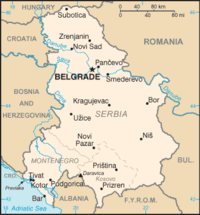Serbia and Montenegro
2008/9 Schools Wikipedia Selection. Related subjects: Europe; European Countries
|
|||||||||||||||||||||||||||||||||||||||||||||
The State Union of Serbia and Montenegro ( Serbian: Државна заједница Србија и Црна Гора / Državna zajednica Srbija i Crna Gora, abbreviated as СЦГ / SCG), was a union of Serbia and Montenegro, which existed between 2003 and 2006. The two republics, both of which are former republics of the SFR Yugoslavia, initially formed the Federal Republic of Yugoslavia in 1992. In 2003, the FRY was reconstituted as a State Union Serbia and Montenegro.
On May 21, 2006, Montenegro held a referendum to seek full independence. Final official results indicated on May 31 that 55.5% of voters had elected to become independent. The state union effectively came to an end after Montenegro's formal declaration of independence on June 3, 2006 and Serbia's formal declaration of independence on June 5. Many view this as symbolizing the final end of what was left from the former Yugoslavia.
A loose confederation, Serbia and Montenegro were united only in certain political areas (e.g. defense). The republics had functioned separately throughout the period of the Federal Republic, and had continued to have individual economic policies as well as using separate currencies (the Euro was the only legal tender in Montenegro).
History
In 2002, Serbia and Montenegro came to a new agreement regarding continued co-operation, which, among other changes, promised the end of the name Yugoslavia, since they were part of the Federal Republic of Yugoslavia. On February 4, 2003, the federal parliament of Yugoslavia created a loose confederation - State Union of Serbia and Montenegro. A new Constitutional Charter was agreed to provide a framework for the governance of the country.
On Sunday, 21 May 2006, Montenegrins voted on an independence referendum, with 55.5% supporting independence. Fifty-five percent or more of affirmative votes were needed to dissolve the state union of Serbia and Montenegro. The turnout was 86.3% and 99.73% of the more than 477,000 votes cast were deemed valid.
The subsequent Montenegrin proclamation of independence on June 3, 2006 and the Serbian proclamation of independence on June 5 ended the State Union of Serbia and Montenegro and thus the last remaining vestiges of the former Yugoslavia.
Administrative divisions
Serbia and Montenegro was composed of two republics, Montenegro and Serbia:
- Serbia (capital: Belgrade)
- Vojvodina – autonomous province within Serbia (capital: Novi Sad)
- Kosovo and Metohija – autonomous province within Serbia under United Nations administration (capital: Priština)
- Montenegro (capital: Podgorica)
The country's political and administrative capital was Belgrade, while its judicial capital was Podgorica.
The territorial organization of the Republic of Serbia is regulated by the Law on Territorial Organization and Local Self-Government, adopted in the Assembly of Serbia on 24 July 1991. Under the Law, the municipalities, cities and settlements make the bases of the territorial organization.
Serbia is divided into 195 municipalities and 4 cities, which are the basic units of local autonomy. It has two autonomous provinces: Kosovo and Metohija in the south (with 30 municipalities), which is presently under the administration of the United Nations, and Vojvodina in the north (with 46 municipalities). The part of Serbia that is neither in Kosovo nor in Vojvodina is called Central Serbia. Central Serbia is not an administrative division (unlike the two autonomous provinces), and it has no regional government of its own.
In addition, there are four cities (gradovi): Belgrade, Niš, Novi Sad and Kragujevac, each having an assembly and budget of its own. The cities comprise several municipalities, divided into "urban" (in the city proper) and "other" (suburban). Competences of cities and their municipalities are divided. Of those, only Novi Sad did not undergo the full transformation, as the newly formed municipality of Petrovaradin exists pretty much only formally; thus, the municipality of Novi Sad is largely equated to city of Novi Sad (and the single largest municipality in the country, with around 300,000 residents).
Municipalities are gathered into districts (okruzi), which are regional centers of state authority, but have no assemblies of their own; they present purely administrative divisions, and host various state institutions such as funds, office branches and courts. The Republic of Serbia is divided into 29 districts (17 in Central Serbia, 7 in Vojvodina and 5 in Kosovo, which are now defunct), while the city of Belgrade presents a district of its own.
Montenegro has 21 municipalities (Општина, opština), and two urban municipalities (градска општина, gradska opština), subdivisions of Podgorica municipality.
Geography
Serbia and Montenegro had an area of 102,350 square kilometres (39,518 sq mi), with 199 kilometres (124 mi) of coastline. The terrain of the two republics is extremely varied, with much of Serbia comprising plains and low hills (except in the more mountainous region of Kosovo and Metohija) and much of Montenegro consisting of high mountains. Serbia is entirely landlocked, with the coastline belonging to Montenegro, which also possessed the only fjord in southern Europe. The climate is similarly varied. The north has a continental climate (cold winters and hot summers); the central region has a combination of a continental and Mediterranean climate; the southern region had an Adriatic climate along the coast, with inland regions experiencing hot, dry summers and autumns and relatively cold winters with heavy snowfall inland.
Belgrade, with its population of 1,574,050, is the largest city in the two nations: and the only one of significant size. The country's other principal cities were Novi Sad, Niš, Kragujevac, Podgorica, Subotica, Priština, and Prizren, each with populations of about 100,000-250,000 people.
Demographics
Serbia and Montenegro had more demographic variety than most other European countries. The three largest named nationalities were Serbs (62.3%), Albanians (mostly Ghegs) (16.6%) and Montenegrins (5%) according to the 1991 census. The country also had significant populations of Hungarians, Roma, Bulgarians, Ethnic Macedonians, Romanians and other eastern Romance peoples (including Aromanians, Megleno-Romanians and Vlachs), plus dozens of other Slavic peoples, namely Bosniaks, Croats, Bunjevci, Šokci, Goranci, Janjevci, Rusins, Slovaks, Muslims by nationality and Yugoslavs. Turkic subgroups still live in Kosovo (mostly Gagauz and Seljuks). There were a number of citizens who declared their nationality as Egyptian and Ashkali. These two were previously regarded as a part of Roma who are of the belief that they originated from present-day Egypt and Israel. Most of the ethnic diversity was situated in the provinces of Kosovo and Vojvodina, where smaller numbers of other minority groups may have be found. The large Albanian population was chiefly concentrated in Kosovo, with smaller populations in the Preševo and Bujanovac municipalities in Central Serbia, and in the south-east of Montenegro ( Ulcinj municipality). The large Bosniak population lived in the Sandžak region on the border between Serbia and Montenegro.
- Total Serbia-Montenegro - 10,019,657
- Serbia (total): 9,396,411
- Vojvodina: 2,116,725
- Central Serbia: 5,479,686
- Kosovo: 1,800,000
- Montenegro: 623,246
- Major cities (over 100,000 inhabitants) - 2002 data (2003 for Podgorica):
- Beograd (Belgrade): 1,280,639 (1,574,050 metro)
- Novi Sad: 215,600 (298,139 metro)
- Priština: 200,000 (2002 estimation)
- Niš: 173,390 (234,863 metro)
- Kragujevac: 145,890 (175,182 metro)
- Podgorica: 139,500 (169,000 metro)
- Prizren: 121,000 (2002 estimation)
- Subotica: 99,471 (147,758 metro)
According to an estimate from 2004, the State Union had 10,825,900 inhabitants.
According to a July of 2006 estimate, the State Union had 10,832,545 inhabitants.
Economy
An extended period of economic sanctions, and the damage to Yugoslavia's infrastructure and industry caused by the Kosovo War left the economy only half the size it was in 1990. Since the ousting of former Federal Yugoslav President Slobodan Milošević in October 2000, the Democratic Opposition of Serbia (DOS) coalition government has implemented stabilization measures and embarked on an aggressive market reform program. After renewing its membership in the International Monetary Fund in December 2000, Yugoslavia continued to reintegrate into the international community by rejoining the World Bank (IBRD) and the European Bank for Reconstruction and Development (EBRD). A World Bank- European Commission sponsored Donors' Conference held in June 2001 raised $1.3 billion for economic restructuring. An agreement rescheduling the country's $4.5 billion Paris Club government debts was concluded in November 2001; it will write off 66% of the debt; a similar debt relief agreement on its $2.8 billion London Club commercial debt has been reached in July 2004; 62% of the debt have been written off.
The smaller republic of Montenegro severed its economy from federal control and from Serbia during the Milošević era. During the Serbia and Montenegro period, both republics had separate central banks, different currencies - Montenegro used the euro, while Serbia used the Serbian dinar as official currency. The two states also had different customs tariffs, separate state budgets, police forces, and governments.
The southern Serbian province of Kosovo, while formally still part of Serbia (according to United Nations Security Council Resolution 1244), moved toward local autonomy under the United Nations Interim Administration Mission in Kosovo ( UNMIK) and was dependent on the international community for financial and technical assistance. The euro and the Yugoslav dinar were official currencies, and UNMIK collected taxes and managed the budget.
The complexity of Serbia and Montenegro's political relationships, slow progress in privatisation, and stagnation in the European economy were detrimental to the economy. Arrangements with the IMF, especially requirements for fiscal discipline, were an important element in policy formation. Severe unemployment was a key political economic problem. Corruption also presented a major problem, with a large black market and a high degree of criminal involvement in the formal economy.
Transportation
Serbia, and in particular the valley of the Morava is often described as "the crossroads between the East and the West" - one of the primary reasons for its turbulent history. The valley is by far the easiest way of land travel from continental Europe to Greece and Asia Minor.
Until the outbreak of the Yugoslav wars, the ironically-named highway "Bratstvo i jedinstvo" (Brotherhood and Unity) running through Croatia, Serbia and the Republic of Macedonia was one of Europe's most important transport arteries. It gradually resumed this role as the security situation stabilized.
Major international highways going through Serbia are E75 and E70. E763/ E761 is the most important route connecting Serbia with Montenegro.
The Danube, an important international waterway, flows through Serbia.
The largest seaport is Montenegro's Bar.
Holidays in Serbia and Montenegro
| Date | Name | Notes |
|---|---|---|
| January 1 | New Year's Day | (non-working holiday) |
| January 7 | Orthodox Christmas | (non-working) |
| January 27 | Saint Sava's feast Day — Day of Spirituality | |
| April 27 | Constitution Day | |
| April 29 | Orthodox Good Friday | Date for 2005 only |
| May 1 | Orthodox Easter | Date for 2005 only |
| May 2 | Orthodox Easter Monday | Date for 2005 only |
| May 1 | Labour Day | (non-working) |
| May 9 | Victory Day | |
| June 28 | Vidovdan ( Martyr's Day) | In memory of soldiers fallen at the Battle of Kosovo |
- Holidays celebrated only in Serbia
- February 15 - Sretenje ( National Day, non-working)
- Holidays celebrated only in Montenegro
- July 13 - Statehood Day (non-working)
Proposed Flag & Anthem
After the formation of Serbia and Montenegro, the Yugoslav tricolour was to be replaced by a new compromise flag. Article 23 of the Law for the implementation of the Constitutional Charter [ ] stated that a law specifying the new flag was to be passed within 60 days of the first session of the new joint parliament. Among the flag proposals, the popular choice was a flag with a shade of blue in between the Serbian tricolour and the Montenegrin tricolour of 1993-2004. The colour shade Pantone 300 C was perceived as the best choice. [ ] However the parliament failed to vote on the proposal within the legal timeframe and the flag was not adopted. In 2004, Montenegro adopted a radically different flag, as its independence-leaning government sought to distance itself from Serbia. Proposals for a compromise flag were dropped after this and the Union of Serbia & Montenegro never adopted a flag.
A similar fate befell the country's anthem and coat-of-arms to be; the above-mentioned Article 23 also stipulated that a law determining the State Union's flag and anthem was to be passed by the end of 2003. The official proposal for an anthem was a combination piece consisting of one verse of the Serbian anthem " Bože pravde" followed by a verse of the Montenegrin anthem, " Oj, svijetla majska zoro". This proposal was dropped after some public opposition, notably by Serbian Patriarch Pavle. [ ] Another legal deadline passed and no anthem was adopted. Serious proposals for the coat of arms were never put forward, probably because the coat of arms of the FRY, adopted in 1994 combining Serbian and Montenegrin heraldic elements, was considered adequate.
Thus, the State Union never officially adopted state symbols and continued to use the flag, arms and anthem of the Federal Republic of Yugoslavia by inertia until its dissolution in 2006.
Sports and contests
Serbia and Montenegro were represented by a single football team in the 2006 FIFA World Cup tournament, despite having formally split just weeks prior to its start. Following this event, this team has been inherited by Serbia, while a new one was to be organized to represent Montenegro in future international competitions. Their most notable player is Manchester United defender Nemanja Vidić, who is Serbian.
They were represented by a single team in the Basketball World Championship 2006 as well. This team was also inherited by Serbia after the tournament, while Montenegro created a separate national basketball team afterwards, as well as the national teams of all other team sports.
The two countries were represented in the Miss Earth 2006 pageant by a single delegate, Dubravka Skoric. It is unknown if the two countries would field two different candidates in the pageant's succeeding editions.
Serbia is home to three of the worlds top tennis players. Novak Đoković is currently ranked #3 in the world, and in 2007, was a U.S. Open finalist. Đoković is considered to be one of the best players and may be the one to over take Roger Federer. Jelena Jankovic is currently the fourth best women's player and has reached very far into many gram slams. Lastly, Ana Ivanovic is currently ranked second in the world and was the 2007 French Open finalist, she also reached the semi finals of Wimbledon in 2007, and in January 2008 she reached the finals of the Australia Open. Ivanovic was also on the cover of the October Issue of TENNIS Magazine.





